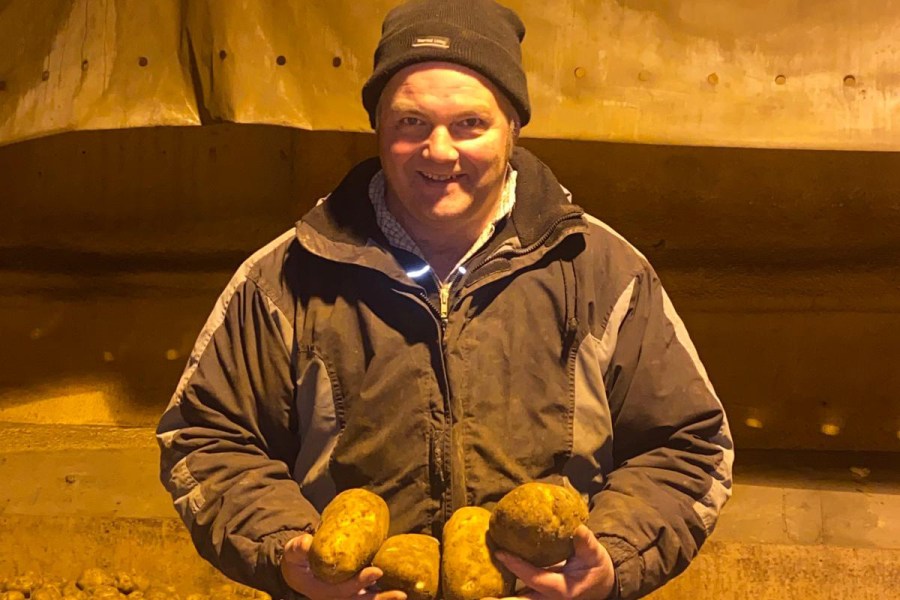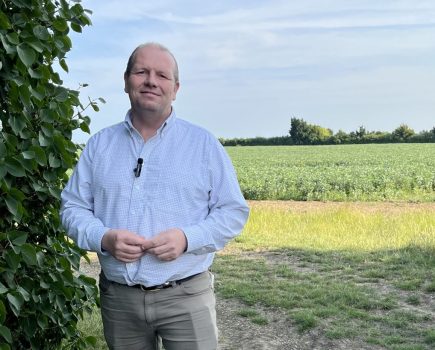by Andrew Wilson
Contrasting years don’t vary much more than 2024 and 2025. We finished planting this year’s crop more than a month earlier than last year and are currently at a point where all pre emergence herbicides are on, the earliest crops have had two blight sprays, and it’s still a week before we’d finished planting last year!
Is this a good thing? Mostly, yes. Crops went into moisture in most cases, and that together with some higher temperatures, has pushed things on nicely. As is the case in most years, my chitted crops are a fortnight ahead of the unchitted, having emerged 19 days after planting and reached tuber initiation by the end of May. The trade-off of warmer days and some rain of course, is blight pressure, and the demand for irrigation.
I have a soil moisture probe in one field to add some structure beyond my hand to our irrigation decisions. At the driest, even before emergence, field capacity went down to 44%. We then had just above an inch of rain spread over a week, which pushed it up to 57%, but it’s dropped back a bit since.
As I write this, we’re just about ready to irrigate potatoes and have a reel on some beet, but irrigating isn’t a job we get excited about here. We have quite a lot of kit to water in various locations but it’s all antiquated – we don’t have the luxury of nice electric boreholes controlled remotely and underground mains with well-placed hydrants, so it’s all rather 1990s and hard work.
The juggernaut that is blight seems to gain momentum every year and with an ever-reducing armoury to control it, extra vigilance and attention to detail is vital. Early season mancozeb has been the backbone and later brought multi-site activity among its attributes as primarily a partner product. It’s been around for more than sixty years but will be no longer a tool that we can use in the UK after this season.
My thinking, as ever, goes back to basics. Copper is the mainstay of organic blight control, and is a component of mancozeb along with zinc (as under-rated a nutrient as calcium in my opinion) and manganese, which is nearly as essential as the oil in an engine.
It makes me consider how mancozeb came about, and why those trace elements are within it – it’s obviously for a reason. There’s more to blight control than nutrition of course, but this season we’re researching and trying biological trace element products containing these important nutrients.
This principle will be used in a tank mix with cymoxanil or dimethomorph as the demand arises, but not too frequently. I’m also to attend the mancozeb summit at Rothamsted Research next week, so will undoubtedly learn more there.
Mancozeb is but the tip of the iceberg though. CAA’s need spacing out, if for no other reason to protect cyazofamid (Ranman) which has played a part in improving the efficacy of contact weed control, sprout control and desiccation here in recent years.
Mandipropamid (Revus) is usually an early season product of choice particularly where we can irrigate, with propamocarb (Infinito) used later on. Resistance to oxathiapiprolin (Zorvec) is a cause for concern, so it will be held back in case we have a case to ‘roll out the big guns’, which for us is usually late August.
On a more positive note, fluazinam resistance appears to be restricted to Scotland, so that will see a little more use than of late primarily as a partner product, likely alternated with cymoxanil.
There are many salespeople around plying their wares of the next big thing in agronomy these days. For years though, we’ve had good results from placed biostimulants against rhizoctonia, so using them proactively on the foliage against early dying syndrome too seems a sensible idea. Planning is important though; they have to be on before high sun or drought stresses the crops too much.
My beet is a mixed bag currently, with the line where soil types change very visible. Where it’s good it’s very good, but there’s about 15% of it struggling at the moment. Such things can soon knock the finances of the crop into a negative position, so we’re irrigating it in an attempt to strengthen any weak plants.
Aphids have fortunately left it alone so far, and the next job to do to the crop is to scruffle it (inter-row hoe) to knock out weeds and mineralise some nitrogen. It’s rare to not see a positive response to this from the crop – unfortunately that feel good factor doesn’t extend to the operator!
Cereals have plenty of variation. Winter barley looks good to drive past but it’s too easy to walk through it, it just lost too many tillers over winter. Wheat is mostly okay bar two fields with a patchwork of burned off areas where blackgrass has shown itself to be present.
In the workshop we’re about halfway through the pre-harvest servicing. Trailers particularly get a full strip down of hubs and brakes, greaseways cleaned, bushes checked and any worn pipes, wires or tyres replaced as necessary. One trailer is ready for a new floor at 17 years old, but is in otherwise decent condition so it will be done. We document all of this work in a file and are considering a rolling road test when we get them all serviced.
Downtime and accidents are more expensive than proper servicing in my opinion, so it’s best to be thorough.
This article was taken from the latest issue of CPM. Read the article in full here.
For more articles like this, subscribe here.
Sign up for Crop Production Magazine’s FREE e-newsletter here.




